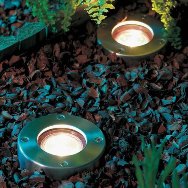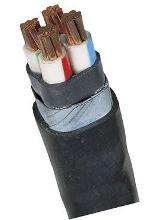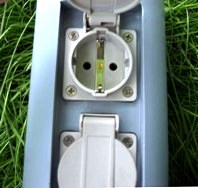Categories: Featured Articles » Electrician at home
Number of views: 34835
Comments on the article: 1
How to lay the cable and connect the fixtures in the garden
 Landscaping ... What is it? Many will answer that these are beautiful shrubs, trees and neatly trimmed grass. But in fact, this is real art! Art with a thousand-year history. Remember at least the Hanging Gardens of Babylon (Babylon). And although they were built more than two thousand years ago, the glory of them has survived to this day and still amazes our imagination with its splendor.
Landscaping ... What is it? Many will answer that these are beautiful shrubs, trees and neatly trimmed grass. But in fact, this is real art! Art with a thousand-year history. Remember at least the Hanging Gardens of Babylon (Babylon). And although they were built more than two thousand years ago, the glory of them has survived to this day and still amazes our imagination with its splendor.
Landscaping today is a science. When designing the future home, almost every homeowner preplans the location of not only the house and outbuildings, but playgrounds for recreation and sports, various lawns, ponds, trees and shrubs, paths and lamps ... That’s all that can be called landscape design.
It’s rather difficult to think through everything on your own. Indeed, when designing, one should take into account not only the location of plants, paths and buildings, but also automatic irrigation systemdrainage for water, lighting, etc. A specialist - a landscape designer will help you figure this out.
A significant role in all this diversity is given to lighting. Lighting can be divided into decorative and working. But the speech, in this article, will not be about lamps, but about how to correctly and correctly bring electricity to these same lamps, which cables must be used and what you need to know for this.
 So, it is best to use a cable specially designed for this to power the fixtures. An ideal option would be to use an armored cable, for examplecable VBBSHV or AVBBSHV (aluminum conductors).
So, it is best to use a cable specially designed for this to power the fixtures. An ideal option would be to use an armored cable, for examplecable VBBSHV or AVBBSHV (aluminum conductors).
Such a cable, thanks to protective armor, is protected from accidental mechanical damage. The insulation of the cable from polyvinyl chloride plastic compound (PVC) will protect the cable from the aggressive effects of soil.
In addition to the armored cable, cable laying without armor is possible. But in this case, it is recommended to lay the cable in asbestos-cement or polyethylene pipes.
Many electricians use to protect against mechanical damage. plain corrugated pipe or a metal hose. This, let's say, is not entirely correct. The fact is that such a pipe is not intended for laying in the ground. Literally a year later, under the influence of salts and acids contained in the soil, it simply crumbles, and the metal rots. As a result, the cable will remain unprotected.
 One of the most important rules when laying highways is the depth of the cable. In the middle zones, the cable is usually laid to a depth of at least 70 cm from the surface. This is due to the fact that the soil freezes at about this depth. If the climate in your region is more severe and the freezing depth is greater, then, therefore, it is necessary to lay the cable below this depth. Otherwise, the frozen ground will simply break the cable.
One of the most important rules when laying highways is the depth of the cable. In the middle zones, the cable is usually laid to a depth of at least 70 cm from the surface. This is due to the fact that the soil freezes at about this depth. If the climate in your region is more severe and the freezing depth is greater, then, therefore, it is necessary to lay the cable below this depth. Otherwise, the frozen ground will simply break the cable.
When laying the cable in the ground, it is not necessary to give a strong tension, let it be better with a little "sag" in case of subsidence of the soil. Before backfilling the cable with soil, the soil must be sieved so that stones and foreign objects do not damage the cable.
If the cable is protected by a polyethylene pipe, the ends of the pipe should be tightly closed to prevent moisture, pebbles, foreign objects from entering it.
 To prevent electric shock, many manufacturers produce lamps with lamps designed for low voltage. In this case, you should be very careful and serious about the cross-section of the cable cores, the connection method.If the cable cross section turns out to be small, the voltage drop along the cable length will be so large that the lamp at the end of the circuit will shine an order of magnitude less than the first in the same circuit.
To prevent electric shock, many manufacturers produce lamps with lamps designed for low voltage. In this case, you should be very careful and serious about the cross-section of the cable cores, the connection method.If the cable cross section turns out to be small, the voltage drop along the cable length will be so large that the lamp at the end of the circuit will shine an order of magnitude less than the first in the same circuit.
To connect outdoor lighting in the distribution panel, you must use a separate circuit breaker. The circuit breaker rating must be appropriate for the load. Also does not hurt to turn on the circuit RCD. It (RCD), in the event of a current leak, will work, thereby preventing an electric shock.
Installation work should be trusted by professional installers. At the end of all work, ask to check the cable for breakdown. It is also necessary to make a detailed plan on which all communications, including electric cables, will be applied.
Compliance with such simple, at first glance, Rules will significantly increase the service life of cable networks and make their operation safe.
Sergey Seromashenko
See also at bgv.electricianexp.com
:
